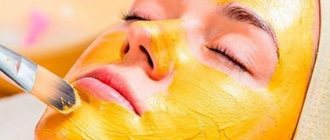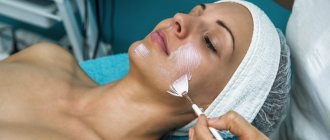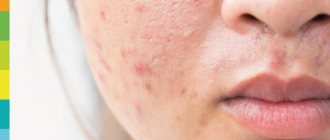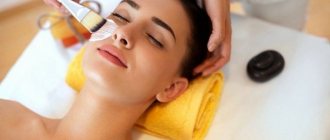The skin of the face is constantly exposed to adverse factors - wind, sunlight, dust, temperature changes. Over the years, its elasticity and firmness decrease, blood flow deteriorates, pores become clogged, various inflammations may occur, and age spots may appear. Timely cleansing and peeling helps restore the skin to a healthy appearance and youth.
These popular beauty treatments are designed to exfoliate the stratum corneum of the skin and improve the formation of new cells. Depending on the depth of action of the active components, peelings are divided into superficial, medium and deep. Superficial peels are the most gentle, so they can be done all year round. But medium and deep peels are performed, as a rule, from October to February.
Description of peeling
Croton peeling
is a type of chemical peeling that differs from others in the content of crotonic acid, which is extracted from the seed oil of the Croton tree, which grows on the island of Sri Lanka and in China. Research has proven that the resulting oil noticeably removes not only the appearance of wrinkles, but also evens out the skin texture itself. The population of these territories has long been using this oil for rejuvenation.
In a hospital, instead of deep phenol peeling, you can peel with croton oil, the effect will be the same, only the whitening effect of croton oil is less pronounced, which gives it an advantage, since the skin does not lose pigment. Plus, the carbolic acid used in phenol peeling is more toxic, so recently plastic surgeons are more often using croton oil for deep peeling.
Beauty salons offer Krotonic peel containing crotonic acid (manufactured by GiGi Cosmetic, Israel). The peeling also contains glycolic and kojic acids, vitamins A, C, E, phenol, bearberry extract, azulene, Dead Sea minerals, and moisturizing components. This peel can have a superficial or medium effect depending on the number of layers, exposure time and enhancement applied.
In the Krotonic peel peeling, crotonic acid improves the activity of other components and promotes their penetration into the dermis. The purpose of this peeling is to improve the texture of the skin and rejuvenate it. Krotonic peel is used to combat crow's feet, laugh lines, superficial and deep wrinkles caused by UV rays or hereditary factors. This peeling is effective in the fight against age spots of any origin. It gently evens out the skin, which allows you to get rid of post-acne manifestations. Croton oil peeling can also be used in the fight against keratoses and melasma.
Mandelic
The Israeli cosmetics company's huge variety of exfoliating products makes it easier for customers to choose the right option. GiGi almond peeling is designed to meet the needs of all types, and will also become indispensable for those with sensitive and pigmented skin at any age. The main ingredients of the composition are vitamin C and almond extract, which are aimed at rapid lightening, cell regeneration and have an anti-aging effect.
After use, the natural skin tone is noticeably evened out, pigment spots are reduced, the surface is smoothed and becomes softer. According to buyers, peeling can prevent the appearance of the first signs of aging and reduce existing wrinkles. Professional cosmetologists recommend applying a soothing mask to eliminate irritation and redness after the cleansing procedure. Peeling is often used in beauty salons and at home, as it is highly effective in combating uneven skin tone and unwanted pigmentation.
Properties of the active component
Crotonic acid
or 2-butenoic acid is a monobasic unsaturated carboxylic acid. This acid gets its name from the croton laxative plant (Croton tiglium), as it is part of the oil obtained from this tree. It is also formed in the body of humans and animals during the breakdown of fats. Crotonic acid has an unpleasant pungent odor from sweat. It is a weak acid with a pronounced irritant effect, which, if the concentration is incorrect, can lead to disastrous consequences.
Crotonic acid has the following effects on the skin:
1. exfoliating effect
2. stimulates the synthesis of glycosaminoglycans and proteins
3. leads to the destruction of melanocytes
4. penetrates to the reticular layer of the dermis
5. activates the action of other substances
6. stimulates skin fibroblasts, thereby causing collagen production.
Indications and contraindications
Indications
For mature skin:
• Correction of age-related periorbital and perioral wrinkles; • Elimination of the network of wrinkles on the cheeks; • Elimination of small and medium superficial wrinkles; • Reducing the depth of wrinkles caused by UV radiation, hormonal changes or hereditary factors; • Flabbiness and decreased skin tone; • Actinic keratosis; • Hyperpigmentation and uneven complexion; • Heterogeneous skin texture; • Melasma; • As preparation for other types of peelings.
For young skin:
• Acne (without stagnant elements) and post-acne; • Problem skin; • Persistent chloasma after pregnancy; • Scars and scars.
Contraindications
1. Intolerance to peeling components 2. Recent plastic surgery (no earlier than 2-3 months later) 3. Cosmetic procedures less than a month old 4. Taking oral contraceptives and photosensitive medications (in this case, you will need to be especially careful to avoid exposure to UV rays skin after peeling) 5. Herpes in the relapse stage (herpes treatment should be completed several days before peeling) 6. Persistent rosacea 7. Burns 8. Increased body temperature 9. Menstrual period 10. Exposure to prolonged insolation 11. Violation of integrity and sensitivity skin 12. When treating keratosis and melasma, consultation with an oncologist-dermatologist is necessary 13. Pregnancy and lactation 14. Infectious diseases 15. Mental illnesses 16. Kidney and liver diseases 17. Presence of heart failure
Features of Gigi multi-peeling
Multi-peeling from Gigi has multiple effects on the skin. It simultaneously cleanses it of fat and keratinized particles produced by the sebaceous glands, and helps to recover by stimulating cell synthesis. This feature allows the product to be used even by those whose skin is sensitive and prone to irritation.
The effect can be achieved with a single procedure. After it, the skin takes on a healthier appearance, its surface becomes smoother and denser due to an increase in moisture content. The result will be regardless of its type. Multipeeling has a beneficial effect on dryness, increased sebum secretion, and aging.
We recommend reading about salicylic acid peeling. You will learn about the indications for this type of peeling, the features of its implementation, contraindications, and side effects. And here is more information about performing superficial facial peeling.
Pros and cons of croton peeling
Pros of croton peeling:
— Good anti-aging result;
— Effective in the treatment of acne and post-acne;
— Affects pigmentation of any origin;
— Suitable for both mature and young problem skin;
— You can perform superficial or medium peeling depending on the problems being solved.
Photos before and after croton peeling
Effect of croton peeling
It should be noted that the lasting effect of croton peeling can be fully assessed only after three months (2 full skin cycles must pass) from the first procedure.
Results of the procedure:
• Reducing the number and depth of wrinkles; • Skin texture is evened out; • Noticeable lifting effect: chin sagging is removed and nasolabial folds are reduced; • The skin becomes elastic and soft; • Skin whitening by stopping the process of melanocyte formation; • Removal or significant lightening of age spots; • Increasing the overall tone and turgor of the skin; • Skin polishing effect; • The skin takes on a healthy, fresh and radiant appearance.
Cons of croton peeling:
— Large list of contraindications;
— A rehabilitation period with the use of special care products is required;
— Pre-peeling preparation is required to prevent complications; — Painful procedure;
— The effect is not immediately visible;
— Can only be carried out during periods of least solar activity.
The Fitzpatrick scale is used to determine whether a patient is suitable for a Croton peel. It divides skin types depending on pigmentation and tendency to scarring. People with skin type 5 are more suitable for croton peeling; they are not prone to hyperpigmentation and scarring after the procedure. People and types 3 should regularly use sunscreen and carry out thorough pre-peel and post-peel care when undergoing croton peeling.
And according to the Glogau scale, people with skin types 2 and 3, that is, between the ages of 30 and 60 with signs of photoaging and facial wrinkles, are most suitable for croton peeling.
Rice
This product is considered one of the most gentle and gentle of the entire range of cosmetics companies. Its formula is designed in such a way that the components act on the upper layer of the epidermis, eliminating dead cells. GiGi rice peeling is an ideal option for sensitive, problematic and pigmented skin. The main properties are to lighten dark spots on the surface, stimulate regeneration, heal inflammation, prevent the appearance of facial wrinkles and smooth the face. Buyers in the reviews note that it can be used after 25 years at any time of the year.
After applying the product there is no unpleasant sensation, there is no burning or redness of the skin. Gentle exfoliation of the stratum corneum ensures active air circulation into the cells, improving natural tone, eliminating peeling and lightening unwanted pigmentation. Peeling should be used on damp skin, spreading with massage movements and rinsing with cool water.
Pre-peeling preparation
For almost any chemical peel, the skin must be prepared in advance. It is best to use the services of the same salon where you are going to perform croton peeling. Pre-peeling preparation begins 3-4 weeks before the procedure, and it is needed in order to:
- even out the stratum corneum of the skin; — adapt and prepare the skin to the aggressive effects of acids; - identify allergies to acids; — the peeling composition evenly penetrated deep into the skin; — accelerate regeneration processes; - reduce the risk of developing pigmentation by reducing melanin production.
If pre-peeling preparation is carried out in accordance with all requirements, then the risk of complications will be reduced to zero.
Most likely, in the salon you will be offered to use products from the “Retinol Forte” series to accelerate the regeneration of the epidermis. From this series you can use a night repair cream (Retinol Forte Night Repair Cream), which activates keratinocytes and fibroblasts of the skin due to carrot seed oil and lycopene. These oils are direct substitutes for retinol (vitamin A). The cream will help renew the collagen and fibrin composition of the epidermis; it should be used within a month before the procedure. In addition to retinol, you should also use preparations with other antioxidants (selenium, vitamins E, C, lipoic and succinic acid) to stimulate the skin's immune system (increasing the skin's resistance to infections).
To reduce the risk of pigmentation, 2-3 weeks before mole peeling, you should use whitening preparations (arbutin, ascorbic and kojic acids, citrus, parsley, yarrow or cucumber extracts) or a whitening cream (Skin Lightening Cream) from the Retinol Forte series.
You should also carry out a Glycopure peeling procedure a month earlier, which will help reduce the risk of pigmentation, improve the penetration of the peeling composition into the dermis and carefully remove the stratum corneum of the skin. Or some other peeling with a low content of fruit acids, depending on skin problems, such as lactic, almond or glycolic.
You should also use moisturizers with hyaluronic acid or glycerin daily for 2-3 weeks, creams that are suitable for your skin type.
To prevent the herpes virus, antiviral and immunomodulatory drugs (acyclovir, valacyclovir, isoprinosine, Valex, Panavir) are prescribed 2-3 weeks before the procedure. The choice or combination of drugs remains with the dermatologist.
For 3 weeks before peeling, you should use sunscreen with SPF of at least 30.
In addition to cosmetic procedures, it is worth undergoing a number of examinations that can detect diseases of the kidneys, liver and heart. It is also worth notifying your cosmetologist about the medications used. 3-6 months before the procedure, you need to stop taking retinoids, as they thin the epithelium and increase the photosensitivity of the skin, and therefore can lead to complications after the procedure (burns, pigmentation).
3 months before croton peeling, you should avoid visiting resorts and solariums.
Progress of the procedure
To carry out croton peeling (Krotonic Peel) from GiGi Cosmetic, 5 preparations are used:
1. Liquid face soap (Face soap) with pH 3.5
2. Pre-peel toner with pH 3.5
3. Composition for croton peeling (Krotonic peel) 15%, based on glycolic and crotonic acids
4. Neutralizer gel with pH 8, which converts active acids into moisturizers and returns the pH level to normal
5. Spray lotion “Isotonic mist” with pH 6.5.
Local anesthesia can be used before the procedure itself, but it should only be performed by a specialist. As a rule, local anesthesia is used with lidocaine, novacaine or ultracaine.
Croton peeling protocol
Croton peeling is done once every 2-3 weeks, in a course of 4-6 procedures.
1. Cleansing and makeup removal.
First, liquid soap is applied to the skin to cleanse the skin of makeup and impurities. Next, it is washed off by a cosmetologist using rough sponges.
2. Degreasing and toning.
A pre-peeling tonic is used, which is applied with pressing movements over the entire surface of the face using cotton or gauze pads.
3. Croton peeling.
Croton peeling gel is applied using a special stick. This gel can be applied in several layers, depending on the desired result. The length of time the gel is left on the face also depends on the result, but on average this stage lasts 10-15 minutes. When using for the first time, it is recommended to apply one layer (pre-peeling), wait 1-2 minutes and ask the patient about his sensations. If he does not feel a strong burning sensation, and the skin reaction to the peeling composition is normal, then a second layer can be applied. We apply the drug first to the forehead and temple area, then to the cheeks, neck, chin and cheekbones, and then to the center of the face on the nose, perioral and orbital zones.
For repeated procedures, a fan or fan can be used to eliminate the burning sensation and make the patient feel better.
4. Neutralization.
When the first signs of hyperemia appear or after the exposure time has expired, the croton gel is not washed off, but is neutralized with Neutralizer, which the master applies to the skin with gloves in the reverse order of application.
5. Moisturize.
The final step is to spray an isotonic spray lotion all over the skin, which is then rubbed into the skin with smooth massage movements.
6. Protection.
Apply sunscreen with SPF of at least 30.
Reviews
According to cosmetologists and buyers from different countries, peelings from this cosmetic brand can satisfy absolutely any need. Unique formulas, natural ingredients, wide spectrum of action and high efficiency are the main advantages of GiGi peelings. Reviews show that if used correctly, results can be noticed immediately after the procedure.
Cosmetologists claim that it is necessary to carry out all the main stages - preparation (removing decorative cosmetics), applying and maintaining the recommended time for exposure, as well as removing the remnants of the care product only after complete drying. Thus, the cells receive all the useful components and the maximum effect from using the product is achieved.
Post-peeling care
Croton peeling is quite aggressive and requires rehabilitation after the procedure.
You should use soothing, moisturizing and restorative products, which the cosmetologist will select based on your skin type and the problems that need to be solved. Most often these are products from the GiGi Cosmetic line. After croton peeling, it is also advisable to use vitamins C, A, E and other antioxidants. The cosmetologist can prescribe antibiotics and painkillers if necessary.
Recommendations for skin care after croton peeling:
-It is not recommended to wet the skin during the first day.
-You cannot sunbathe during the entire course of croton peeling and a month after it; you should regularly use sunscreen with SPF 30.
-It is not recommended to apply makeup for 2-3 days.
-It is also not recommended to rip off flaky skin, much less crusts that could have formed during deeper exposure. Try to touch your skin with your hands as little as possible.
Opinion of cosmetologists
Doctors regularly use GiGi in their work. Professional cosmetics allow you to really achieve your goals. Treatments with brand variants are offered to patients regularly, but the high price of GIGI products is often the deciding factor for consumers.
The cosmetologist offers treatment using GiGi peeling.
The cosmetologist offers an option from GiGi.
The cosmetologist likes GG products, but considers the price too high.
Possible complications after croton peeling
1. Hyperemia.
Occurs in all patients and goes away within the first hours after peeling. If it does not go away within 24 hours, you should contact a cosmetologist. Treatment with anti-inflammatory and antihistamine drugs.
2. Edema.
It happens very rarely. If observed immediately after the procedure, then a cold compress and lifting massage should be done.
3. Itching.
May occur 2-3 days after peeling. Do not comb or tear off scales. Cold compresses with chamomile and antihistamines.
4. Peeling.
Usually minor on the 3rd – 4th day. Depends on the characteristics of the skin and the depth of exposure to croton peeling. If the peeling is severe, then it is better to go to the salon and have a cosmetologist perform this procedure himself.
5. Allergies.
Pre-peeling should be carried out to identify allergic reactions to the components of the drug.
6. Hyperpigmentation.
The risk of dark spots is higher in women with dark skin. To prevent hyperpigmentation, it is worth using bleaching agents before the procedure. For example, a cream with vitamin A, which normalizes the process of reproduction of pigment cells. Dark spots after peeling will disappear quite quickly with regular use of sunscreen.
7. Infections and skin rashes.
If any rash appears, you should consult a doctor, he will determine the cause. It may be due to allergies or improper skin care. Antimicrobial and antibacterial drugs are used for treatment.
8. Exacerbation of herpes.
Prophylaxis should be carried out before the procedure. Treatment with antiviral and immunomodulatory drugs.
9. Burn.
If the peeling protocol is not followed or if the skin is particularly sensitive.
Precautionary measures
Side effects may occur if the procedure protocol is not followed or if there is a tendency to allergic reactions.
Increased dryness indicates that the acid has burned the protective barrier and the skin has become thinner. For restoration, moisturizing and regenerating preparations are used.
1st and 2nd degree burns require long-term competent treatment and constant medical supervision.
Contraindications
- Exacerbation of herpes;
- Demodectic mange;
- Cuperosis;
- Individual intolerance to components;
- Chronic diseases;
- Fresh tan;
- Damage to the skin (inflammation, wounds, abrasions);
- Cuperosis;
- Taking retinoids and hormones;
- Pregnancy, lactation.
Cost of croton peeling
The cost of one croton peeling procedure in a salon averages from 1,700 to 5,000 rubles. The full course will cost 8,500-25,000 rubles. The cost of professional products for pre-peeling and post-peeling care from GiGi will cost you on average 9,000-15,000 rubles.
Tags: peeling
Market Analytics
- Global cosmetics market 2022: an unprecedented test for the global cosmetics industry
- Top 10 Cosmetic Research and Development of 2022
- 2020 in the beauty industry – innovation without borders
Convenient search for beauty salons on our website
Beauty salons in Moscow Beauty salons in St. Petersburg Beauty salons in Ekaterinburg Beauty salons in Novosibirsk
Latest blog posts on our website
- Naturecream / Properties of the “Sunny” oil itself
- Naturecream / “Sugar” wrinkles - or what glycation can do
- Naturecream / Esterified oils
- Naturecream / Arnica - the magical plant of alchemists
- Naturecream / Tremella Extract - Snow Mushroom Detox for Skin
- Prostye-sovety / How to visually enlarge your lips with makeup
- Naturecream / Apricot kernel oil for face
- Naturecream / MATRIXYL3000 - the best skin elasticity stimulator
- Naturecream / SPF in Natural Oils
- Naturecream / Geranium (Pelargonium) oil for skin health and beauty
Latest forum topics on our website
- Natalya / How to properly make a gelatin mask?
- Mrs._Smith / Badly sunburned! What to do?((
- Ice / Is it necessary to combine fitness classes with a diet?
- Antonova / What can be used for hair loss?
- Radio operatorKat / Who was on a protein diet?
Reviews about the
Croton facial peeling [Leave a review]
Leave your feedback about this procedure (it will appear on this page after moderation)
In this form, describe only
your personal
experience of undergoing the procedure.
In order to leave a comment regarding the content of the article, use another form - in the “comments” block at the bottom of the page.
Other articles in this section
| Almond peeling for the face Almond peeling is a superficial chemical peeling, which is considered one of the most gentle. The use of peeling with mandelic acid is also possible in the summer, since it does not have photosensitizing effects. It is suitable for people with different skin types, including very sensitive, thin skin. |
| Arginine peeling for the face One of the types of chemical peelings is arginine peeling, which rejuvenates and moisturizes the skin, has a mild exfoliating effect, and prevents the appearance of the inflammatory process. The result is already visible after the first procedure. The skin becomes velvety, matte, elastic, and a healthy complexion appears. |
| Homemade facial peeling Homemade facial peeling, of course, will not replace procedures with a cosmetologist, but it will help keep your skin in good condition. Let's see how you can do facial peeling at home using professional preparations and products that you can prepare at home. |
| Milk peeling for the face Milk peeling is mainly a superficial chemical peeling, with the exception of aggressive preparations from some companies with high concentrations and very low pH, so the effect can be obtained from both a superficial-medium or even a medium peeling. But we will talk about superficial peeling, which affects only the upper stratum corneum of the skin. |
| Peeling with gluconolactone for the face Peeling with gluconolactone is a relatively new type of superficial chemical peeling. It has more pronounced moisturizing properties compared to AHA. The gluconolactone molecule penetrates the structure of the skin more slowly, which avoids the burning sensation that often appears when using other active ingredients. Therefore, peeling with gluconolactone is recommended for people with very sensitive skin. |
| Peeling with lactobionic acid for the face Lactobionic peeling is one of the new generation of chemical peels. It has a complex effect on the skin and is suitable for patients of different age groups. Due to its minimal irritating effect, it is successfully used even on sensitive, acne-prone skin. |
| Microcrystalline dermabrasion (mechanical peeling) for the face In the fight for an impeccable appearance with smooth, satiny skin, without scars, stretch marks and other unaesthetic defects, many methods have been invented. Microcrystalline dermabrasion or mechanical peeling is one of them. It is quite effective and is able to cope with defects such as scars, scars and stretch marks, and also has all the properties of mechanical peeling. |
| Azelaine peeling for the face Azelaine peeling is a procedure for superficial chemical cleansing of the facial skin, prescribed to patients with dermatological problems: rosacea, acne, rosacea and other pathological changes in the skin. Azelaic acid has a bacteriostatic effect against the mite that causes acne. |
| Antioxidant peeling Sun Peel (Sun peeling) for the face Many representatives of the fair sex have overly sensitive skin, so in the summer, pigment spots appear on the face. In order to refresh the skin, give it radiance and get rid of hyperpigmentation, doctors recommend using safe antioxidant peeling Sun Peel. |
| Jessner peeling for the face Jessner peeling is a cosmetic procedure aimed at improving the condition and appearance of the skin using a special chemical composition. An important feature of this peeling is that, in addition to removing the stratum corneum of the epidermis to a certain depth, it promotes active regeneration of skin cells. Another name for the Jessner peel is “Hollywood”: due to the fact that it is extremely popular among movie stars. |
Compound
Croton peeling consists of the following components and acids.
Phenol
It provokes a burn, including affecting the papillary layers of the dermis. In the future, the process is accompanied by the formation and subsequent rejection of crusts. It has a pronounced whitening effect and antiseptic properties.
When using croton peeling, it is necessary to take into account the medications the patient is taking.
Vitamin A, hormonal contraceptives and other drugs have photosensitizing properties, so exposure to the sun or visiting a solarium is not recommended.It is important to consider contraindications to the procedure.
Dermatovenerologist, cosmetologist
Zhikhoreva Inna Viktorovna
6 years experience
Glycolic acid
It has a deep effect on the integumentary tissue due to the small size of its molecules. Helps remove dead skin particles from surface layers and cleanse clogged pores.
Koyevaya
Designed to slow down the process of melanin synthesis. It has a whitening effect and accelerates the oxidative processes of phenol.
Croton
With a deep impact on tissues, their rejection occurs at a faster pace.
Bearberry extract
Has antioxidant properties. Helps even out facial tone, cleanse pores, and improve the overall condition of the skin.
Azulene
Has anti-allergenic and anti-inflammatory effects.
Retinol
This is a powerful antioxidant.
Dead Sea Minerals
Relieve inflammation, provide cells with the necessary amount of moisture and nutrition.











